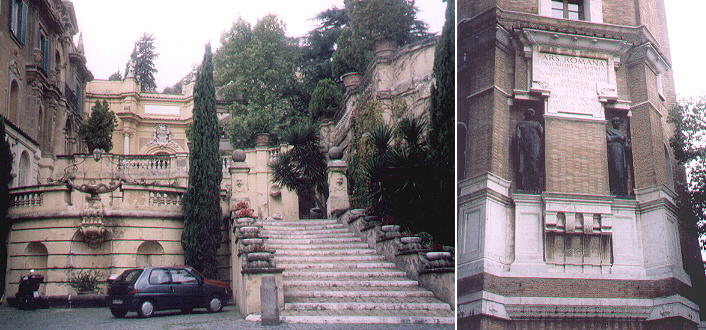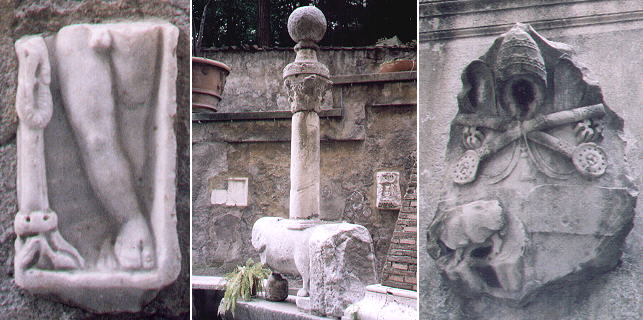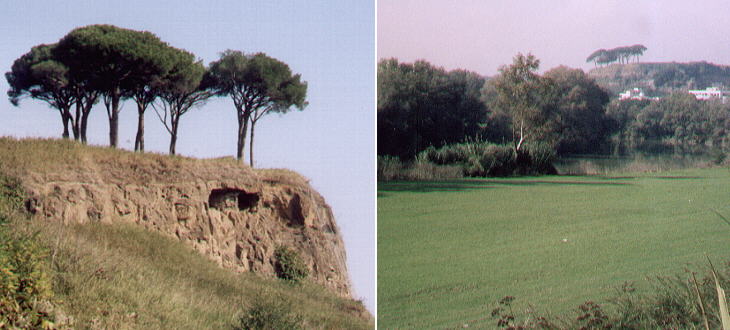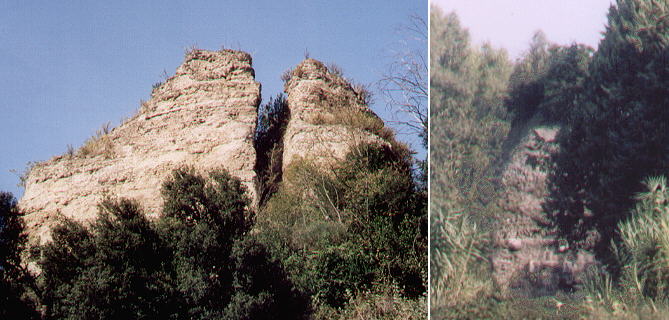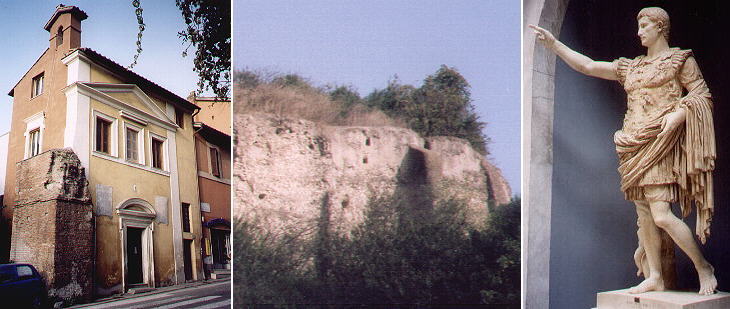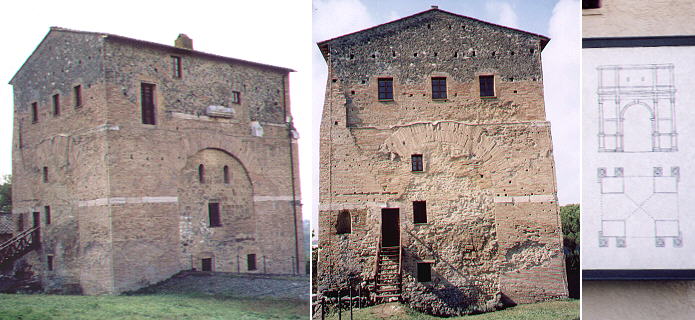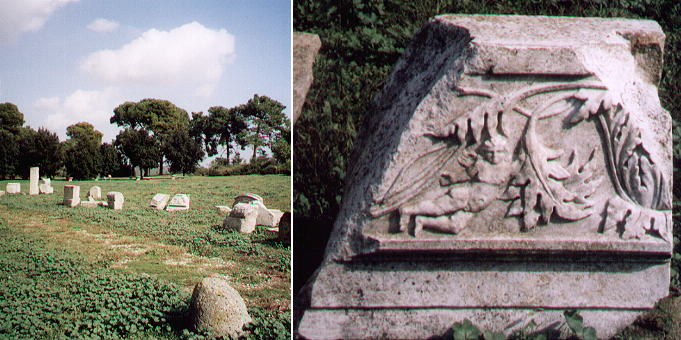  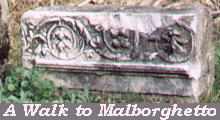 A Walk to Malborghetto A Walk to Malborghetto
a Roman relief found in Villa di Livia
This walk starts from Ponte Milvio and it follows Via Flaminia,
the ancient Roman road
leading to Rimini, a town on the Adriatic Sea. The large expansion of Rome
after World War II has impacted on the landscape of the initial 10 miles of Via Flaminia.
Armando Brasini (1879-1965) was an architect who was very highly regarded by the Fascist government (1922-43) for his monumental buildings where he mixed various styles with results which today are considered very poor. He built a large villa for himself on a hill next to Ponte Milvio and to a monumental bridge he had designed. The villa is made of several buildings giving to the complex the overall shape of a castle, to the point that the locals call it il Castellaccio (the ugly castle). One of the entrances is clearly copying Baroque patterns, while the main tower shows the monumental style developed by Brasini.
Brasini supervised the destruction of old buildings which were promoted by the Fascist government to enhance spectacular views of the Colosseum, Mausoleo di Augusto, Teatro di Marcello, etc. He was allowed to collect many reliefs and fragments of statues, columns, etc. found during these clearances. With them he decorated his villa, sometimes combining them in a rather bizarre way.
Via Flaminia
Via Flaminia heads north towards Civita Castellana, initially following the Tiber. From time to time the buildings of modern Rome give room to sites retaining a rural aspect. The first tufa rocks, typical of the area north of Rome, appear on the left, while on the right one sees the river flanked by meadows which once characterized Prati di Porta Castello. Grottarossa and Celsa
Via Flaminia, although to a much lesser extent than Via Appia, was flanked by funerary monuments. The ruins of a few of them can still be seen among the trees near the river or on the hills overlooking the road, often covered with that picturesque vegetation which made the ruins of Rome so appealing to the travellers of the past. Prima Porta
The White House is the residence of the President of the United States of America; the White Hens (ad gallinas albas) was one of the suburban residences of the Emperor Augustus, or to be more precise of his beloved wife Livia. In 1863 excavations in this villa led to the discovery of a statue of the emperor, which in addition to its high artistic value, is very interesting as it tells us exactly how Augustus wanted to be portrayed for both political and religious reasons. The reference to the white hens is due to a legend telling that Livia dreamt that an eagle had dropped in her arms a white hen holding in its beak a laurel: the dream was interpreted as a favourable indication of glory and wealth and white hens were bred in the villa. The villa was made of several terraces overlooking the river and supported by walls. It had several subterranean rooms providing a refreshing haven during the hottest days. One of them was found in excellent conditions with a fresco decoration showing different plants and animals (now in Museo Nazionale Romano - Palazzo del Collegio Massimo). The statue of Augustus is called Augustus of Prima Porta (first gate), after the name acquired by the location in the following centuries. The aqueduct bringing water to the villa formed over Via Flaminia a sort of gate which travellers saw as the first indication of having reached Rome. Only one pillar of the aqueduct is left next to a small church rebuilt in the XVIIth century by Pope Urbanus VIII and of which the fašade was spared when a modern building replaced the old one. Malborghetto
Malborghetto means evil small hamlet: it does not sound very reassuring: the name given to this building is most likely due to the fact that travellers, who stopped here on the last leg of the journey to Rome, were often robbed. The lower part of the building shows the neat design of Roman masonry, while the upper one is a medieval addition made with stones. The building which was used as a tower, a farmhouse and a coach station was originally built as a triumphal arch dedicated to the Emperor Constantine. The emperor started here the final battle against his rival Maxentius: the battle ended at Ponte Milvio where his enemy fell into the river and was drowned.
some other walks: Walks with Ferdinand Gregorovius in the Roman countryside In and about Viterbo In Maremma Around Monte Cimino From Civitavecchia to Civita Castellana From Bracciano to Viterbo Anticoli Corrado, where the painters found their models A walk to Porta Furba A walk to Ponte di Nona Via Appia Antica from Cecilia Metella to Torre in Selci Via Appia Antica from Torre in Selci to Frattocchie Branching off Via Cassia: S. Maria di Galeria, Isola Farnese and Formello A Pilgrims' Way - Via Francigena On the Edge of the Marsh  or to
The Coats of Arms of the Popes or
to My Home Page on Baroque Rome or to
My Home Page on Rome in the footsteps of an XVIIIth century traveller or to
The Coats of Arms of the Popes or
to My Home Page on Baroque Rome or to
My Home Page on Rome in the footsteps of an XVIIIth century traveller
|
All images © 1999 - 2004 by Roberto Piperno. Write to romapip@quipo.it
